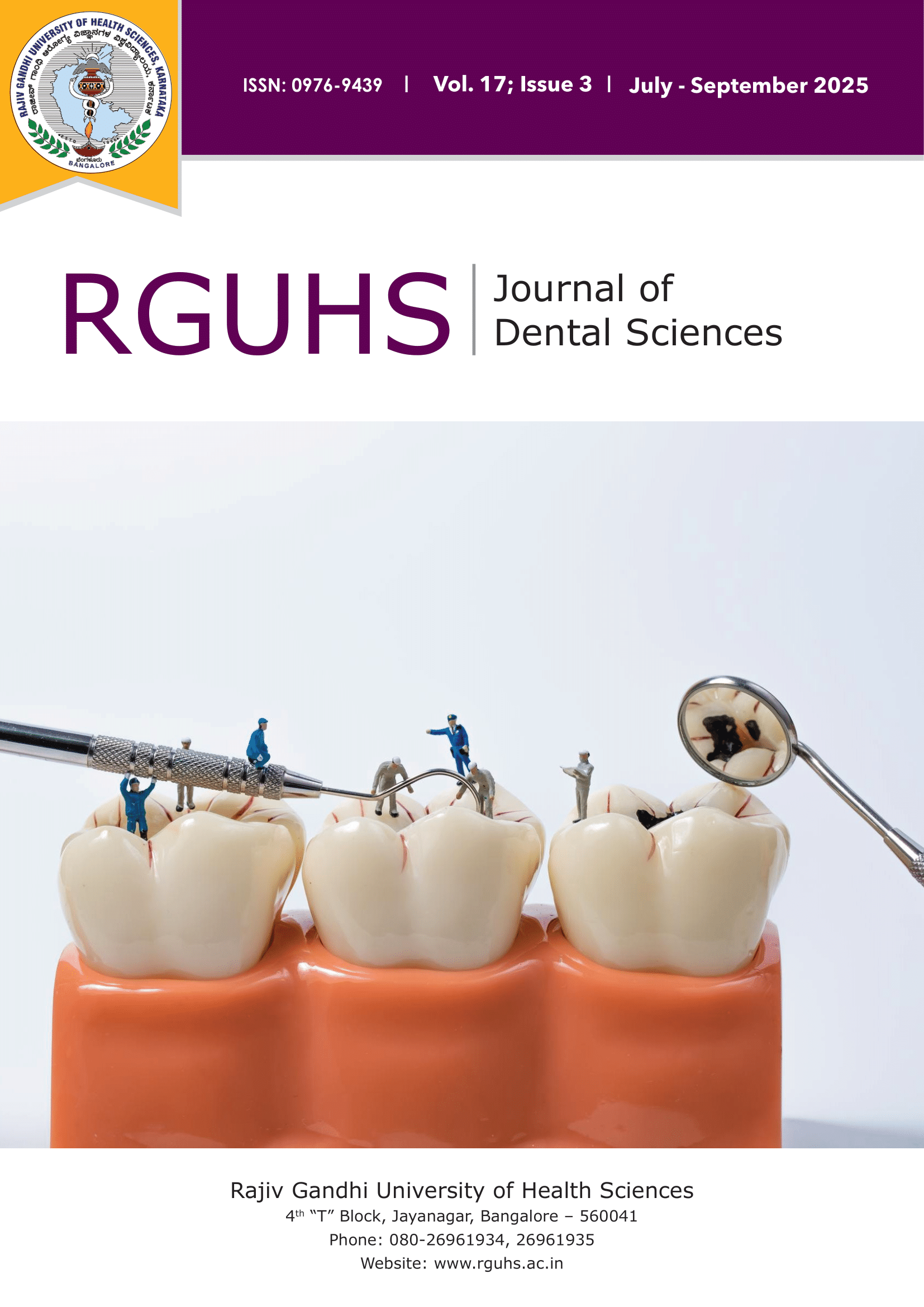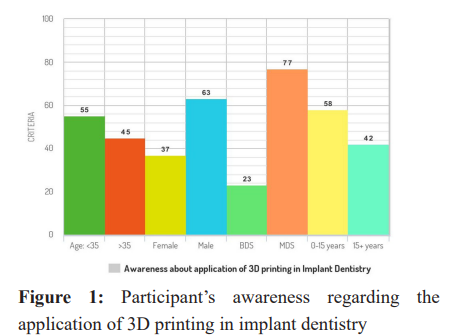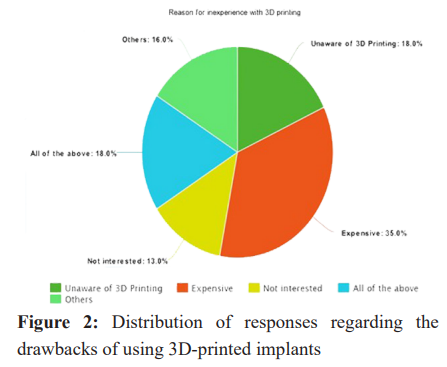
RGUHS Nat. J. Pub. Heal. Sci Vol No: 17 Issue No: 3 pISSN:
Dear Authors,
We invite you to watch this comprehensive video guide on the process of submitting your article online. This video will provide you with step-by-step instructions to ensure a smooth and successful submission.
Thank you for your attention and cooperation.
1Dr. G Abhishek, Senior Lecturer, Department of Dentistry, AIIMS Mangalagiri, Andhra Pradesh, India.
2Department of Oral Pathology, Government Dental College & Research Institute, Bengaluru, Karnataka, India
3Department of Prosthodontics, Government Dental College, Goa, India
4Consulting Periodontist & Implantologist, Bengaluru, Karnataka, India
5Department of Oral Surgery, KLE Dental College, Bengaluru, Karnataka, India
*Corresponding Author:
Dr. G Abhishek, Senior Lecturer, Department of Dentistry, AIIMS Mangalagiri, Andhra Pradesh, India., Email: abhishek656@gmail.com
Abstract
Background:Three-dimensional (3D) printing has revolutionised dentistry, with applications ranging from prosthodontic devices and dental implants to the fabrication of surgical guides, study models, and 3D imaging.
Aim: The present study aimed to evaluate dental practitioners' knowledge and utilization of 3D printing in implant dentistry.
Methodology: A cross-sectional study was conducted using a self-administered, 20-item questionnaire distributed to dental professionals in Karnataka. The survey was made available both as printed copies and as an online version created using Google Forms. The online questionnaire was disseminated through various social media platforms and email to reach willing participants.
Results: Only 5% of respondents were familiar with dental 3D printing, while just 3% understood its underlying principles. About 10% of the participants reported to be aware of the prerequisites, yet 22% were unaware of the ideal materials for 3D printing dental implants. Overall, 58% demonstrated knowledge of all relevant signals. However, only 3% had prior experience using this technology, and within this group, just 1% believed that it improved their surgical performance. The majority (97%) had no prior experience with this technology, primarily because it was unavailable in their field of expertise and prohibitively expensive.
Conclusion: Given the wide range of dental specialties in which 3D printing can be applied, there is a pressing need for experts in this technology within the dental community. Institutional adoption of 3D printing, together with the availability of optional hands-on training, will be essential to ensure its effective and widespread use.
Keywords
Downloads
-
1FullTextPDF
Article
Introduction
Dental procedures that use digital or computer-controlled components rather than mechanical or electrical equipment are referred to as “digital dentistry.”The advent of computer-aided design (CAD), computer aided manufacturing (CAM), and three-dimensional (3D) printing has significantly altered the traditional production approach, which relied on manual work following an oral imprint.1
Since the introduction of the first 3D (three-dimensional) printing technology in 1986, the industrial sector created a wide range of production techniques that are currently used across various industries. In 1986, Hull received a patent for stereolithography (SLA), a pioneering method of 3D printing.2 Scott Crump received a patent for fused deposition modelling (FDM) in 1990. Since then, 3D printing has advanced significantly. Based on digital computer-aided design (CAD) models, 3D printing uses standard materials and pre-established mechanised processes to create bespoke 3D objects.3
Cone beam computed tomography, intraoral scanners, and 3D printing have functioned complimentarily in dentistry, yielding promising outcomes. The field of implant dentistry has enthusiastically adopted 3D printing. A thorough assessment of the literature on 3D printing in dentistry revealed only a limited number of reviews and a lack of in-depth studies, conducted on a large scale.4
Given the gaps in previous research on dental professional's knowledge of 3D printing, this study aimed to assess dental practitioner's knowledge and experiences with 3D printer utilization in Karnataka. The findings are expected to encourage more research into this extremely promising technology, which holds the potential to profoundly alter implant dentistry, making it more patient- and clinician-friendly.5
Dental professionals have limited awareness of the potential uses of 3D printing technology in implant dentistry. This study's objective was to evaluate postgraduate student's, faculty member's, and dentist's knowledge and attitudes toward 3D printing in Karnataka, India. A cross-sectional questionnaire survey was conducted among 350 participants.6
For a long time, technology has been booming in modern dentistry. The practise of dentistry has advanced beyond the traditional skills of dental professionals to embrace the most recent technological developments, offering a distinctive treatment environment for patients seeking quick and effective results. The use of 3D printing technology is poised to revolutionise the manufacturing process.7
Materials and Methods
A descriptive cross-sectional questionnaire survey was conducted among dental practitioners in Karnataka, India, in accordance with the standard statements of the STROBE principles. The study's goals were to evaluate postgraduate student's, faculty member's, and dentist's understanding on the use of 3D printing technology in implant dentistry in Karnataka.
This study involved dental practitioners from Karnataka including BDS graduates, MDS postgraduates, and certified implantologists. Operational definition was utilised for qualified implantologists, including all dental professionals who received training for implant placement. A self-administered questionnaire with 20 close-ended items was validated by two academic experts and the same was used for a cross-sectional investigation.
Dental practitioners who could not be contacted via social media, who declined participation, or who responded after the study period had ended were excluded. The self-administered survey comprised 20 questions: 7 assessed demographic characteristics, 10 evaluated respondent's' familiarity with 3D printing, and the other 20 addressed current use of the technology [Questionnaire pages 1-3].
The face and content validity, reliability, and other psychometric properties of the questionnaire were evaluated. The survey was distributed to 350 postgraduates, academicians, and dental professionals, yielding a response rate of 80%.
The information gathered from this pretested questionnaires was coded and analyzed using the Statistical Package for Social Sciences (SPSS) version 22. P values of 0.05 or lower were considered significant. The Kolmogorov-Smirnov and Shapiro-Wilk tests were used to determine the data's normality prior to analysis. Additionally, the Chi-square test and descriptive analysis utilising frequency distribution were carried out.
The study's findings indicated that the majority of respondents were knowledgeable of 3D printing and its potential uses in implant dentistry. The responses, however, are uninformed about the various 3D printing methods, materials, and equipment. Additionally, there is a need for greater understanding of the clinical uses for this technology.
Results
According to the results, only 78% of participants were aware of 3D printing technology and its potential use in implant dentistry. While most participants expressed support for the technology, their knowledge of its principles and prospective uses was limited. These findings highlight the need for education programmes and training sessions on 3D printing technology for dental practitioners in Karnataka, India.
Table 1 shows study of 350 participants highlights that individuals aged 25-34, males, and those with higher education especially dental faculty show greater awareness and use of 3D printing in dentistry. Private practitioners demonstrate moderate engagement, particularly in implant-related applications. Additionally, practitioners in urban areas, whether working exclusively or across both urban and semi-urban settings, report higher familiarity with 3D printing compared to those in semi-urban locations, suggesting that geographic location influences technological adoption in dental practice.
The bar graph illustrates participant's awareness of 3D printing in implant dentistry across various demographics. Awareness is higher among those under 35 (55%) compared to those over 35 (45%), and among males (63%) compared to females (37%). MDS holders show significantly greater awareness (77%) than BDS holders (23%). Similarly, participants with 0–15 years of experience report higher awareness (58%) than those with over 15 years (42%) (Figure1).
Figure 2 illustrates the distribution of factors contributing to participants' lack of experience. The most cited reason is cost (35%), followed by lack of awareness (18%), combined factors (18%), other reasons (16%), and lack of interest (13%). This highlights that both financial and informational barriers significantly impact the adoption of 3D printing in dentistry.
Discussion
The authors of this study attempted to evaluate the knowledge of postgraduates, faculty, and practicing dentists regarding 3D printing technology and its uses in implant dentistry. To create 3D objects, a computer-controlled process called 3D printing applies successive layers of material. This process is employed in a variety of fields, including aerospace, green building, life-saving medical implants, and even the creation of artificial organs from layers of human cells.8
The findings revealed that while the majority of participants were aware of 3D printing, only a small percentage had actually used it or were familiar with its uses in implant dentistry. This suggests that more information is needed on this subject, particularly for dental practitioners who may apply this technology in their practice.9
To our knowledge, no research has examined the knowledge and application of 3D printing among dental practitioners in Karnataka, highlighting the need for such an investigation. The present study, which provides comprehensive insights into the application of this technology, included representatives from all dental disciplines. Because the study population consisted of dental professionals, there is a greater likelihood that participants have already incorporated this technology into their everyday practice or intend to do so in the future. The use of online survey forms minimized data entry and response errors.10
The study has certain limitations. It excluded practitioners who could not be reached via email or social media. Participation was restricted to practitioners in Karnataka. Furthermore, the questionnaire focused more on the knowledge of the practitioners than on evaluating the therapeutic value and efficacy of 3D printing.
Additional studies could concentrate on technical issues, the patient's response to treatment with 3D-printed appliances or models, clinical success in terms of cost effectiveness, ease of diagnosis, treatment, and prognosis. A more comprehensive, nationwide study with a larger sample size would provide a clearer understanding of the integration of this technology into routine dental practice.
Conclusion
The results of our investigation shed light on the level of knowledge postgraduate students, instructors, and dentists in Karnataka have about the application of 3D printing to implant dentistry. Our results suggest that greater awareness and information-dissemination activities are needed to educate experts in this subject. To support better patient care and informed decision-making, future research should focus on examining different approaches to educating practitioners about emerging technologies, such as 3D printing.
For effective adoption of this technology, dental practitioners should receive instruction at both undergraduate and postgraduate levels, supplemented by optional hands-on training. It is essential that 3D printing be incorporated into the dental curriculum with faculty members actively involved in offering specialized training and orientation programs to enhance practitioner’s familiarity with 3D printing and other imaging modalities. To address and overcome the limitations of this technology, dental professionals must also develop a deeper understanding of its applications and limitations.
Conflict of interest
None
Supporting File
References
- Spagnuolo G, Sorrentino R. The role of digital devices in dentistry: Clinical trends and scientific evidences. J Clin Med 2020;9(6):1692.
- Ngo TD, Kashani A, Imbalzano G, et al. Additive manufacturing (3D printing): A review of materials, methods, applications and challenges. Composites Part B: Engineering 2018;143:172-96.
- Tian Y, Chen C, Xu X, et al. A review of 3D printing in dentistry: Technologies, affecting factors, and applications. Scanning 2021;2021:9950131.
- Pillai S, Upadhyay A, Khayambashi P, et al. Dental 3D-printing: transferring art from the laboratories to the clinics. Polymers 2021;13(1):157.
- Suganna M, Kausher H, Ali AB, et al. Knowledge on applications of 3D design and printing in dentistry among dental practitioners in Saudi Arabia: A questionnaire-based survey. Cureus 2022;14(8):e28379.
- Acharya A, Chodankar RN, Patil R, et al. Assessment of knowledge, awareness, and practices toward the use of 3D printing in dentistry among dental practitioners and dental technicians: A cross-sectional study. J Oral Biol Craniofac Res 2023;13(2):253-8.
- Nayyar N, Ojcius DM, Dugoni AA. The role of medicine and technology in shaping the future of oral health. J Calif Dent Assoc 2020;48(3):127-130.
- Fathima L, Vignesh KR A, Kumar S, Rosan D A, Subramani M, Prabhakar S. Evaluating 3D printing and digital dentistry in dental education and practice: a cross-sectional study on precision applications. Afr J Biol Sci. 2024;6(14):8935-895.
- Rezaie F, Farshbaf M, Dahri M, et al. 3D Printing of dental prostheses: Current and emerging applications. J Compos Sci 2023;7(2):80.
- Marghalani HY, Alghanmi H, Alshammry S, et al. Knowledge, attitude and practice assessment regarding 3D imaging among dental practitioners in Saudi Arabia. Medical Science 2023;27:e27ms2719

